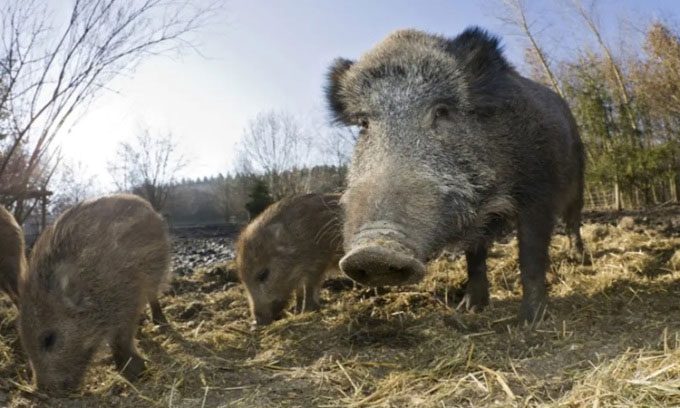The super pig population in Canada poses a significant threat of spilling over the southern border, with states such as Minnesota, North Dakota, and Montana seeking ways to prevent their invasion.
In Canada, wild pigs roam in Alberta, Saskatchewan, and Manitoba, presenting a new danger. They are often hybrid pigs, combining the survival skills of Eurasian wild boars with the size and reproductive rates of domestic pigs, resulting in uncontrollable spreading of “super pigs.” Ryan Brook, a professor at the University of Saskatchewan, refers to wild pigs as “the most invasive species on the planet” and “ecosystem destroyers.”

Wild pigs roaming in Canada. (Photo: Global News).
Pigs are not native to North America. Although they have existed in many parts of the Americas for decades, the issue in Canada only emerged in the 1980s when the country encouraged farmers to raise wild pigs. The market collapsed after peaking in 2001, leading some farmers to dismantle fences and let the pigs roam free.
In fact, super pigs are highly resilient to Canadian winters. Intelligent, adaptable, and hairy, they eat anything, including crops and wildlife. They root through the ground in search of insects and plant roots. Super pigs can spread dangerous diseases such as African swine fever. They reproduce rapidly; a female pig can have two litters a year, with each litter averaging six piglets.
This means that even if more than 65% of the wild pig population is killed each year, their numbers will still increase, according to Brook. Hunting only worsens the problem. The success rate for hunters is around 2-3%. Some states even prohibit hunting as it makes wild pigs more wary and active at night, making them harder to track and kill. Wild pigs cause $2.5 billion in crop damage in the U.S. each year, mainly in southern states like Texas. They can also become aggressive towards humans; a woman in Texas was killed by a wild pig in 2019.
Eradicating wild pigs is no longer feasible in Manitoba and Saskatchewan. However, the situation is not entirely hopeless everywhere, and several states in the U.S. have successfully eliminated them. The key is to have a system in place to identify wild pigs early and respond promptly. Brook and his colleagues have recorded 62,000 sightings of wild pigs in Canada. Their aerial surveys have detected wild pigs on both sides of the Canada-North Dakota border. They also noted wild pigs in Manitoba, within 28 kilometers of Minnesota.
According to Brook, Montana is the most serious state in preventing wild pigs. The state government has banned the breeding and transportation of wild pigs within its borders. They set large traps on the ground and use net guns from helicopters. Some states employ the “Squeal on Pigs” tracking program. Scientists are also researching the use of poisons like sodium nitrite, but this method may harm other species.
Minnesota is among the states actively working to prevent wild pigs from invading. The state’s Department of Natural Resources will release a report in February next year, identifying gaps in management plans and proposing new prevention measures. Meanwhile, the U.S. Department of Agriculture (USDA) uses planes and drones to monitor along the northern border. Minnesota claims to have successfully eradicated wild pigs after the Department of Wildlife killed a herd of pigs in 2016 that had escaped from a farm and bred in a sanctuary. Gary Nohrenberg, director of the Minnesota Wildlife Agency, stated that no true wild pigs have entered the state.
Pseudorabies has been reported in at least 35 states across the U.S., according to the USDA. They estimate that the wild pig population in those states totals around 6 million. Since the introduction of the National Wild Pig Management Program in 2014, the USDA has provided funding to 33 states, according to Mike Marlow, the program’s assistant director.
Marlow stated that their goal is to eradicate wild pigs while populations are still small or newly established, while also limiting the damage they cause in Texas and southeastern states. The program has seen success in some states with small populations of pigs such as Vermont, New York, Pennsylvania, New Hampshire, Wisconsin, and Washington. “I think we’ve made significant progress towards success. But eradicating wild pigs will not be achievable in the near future,” Marlow said.


















































